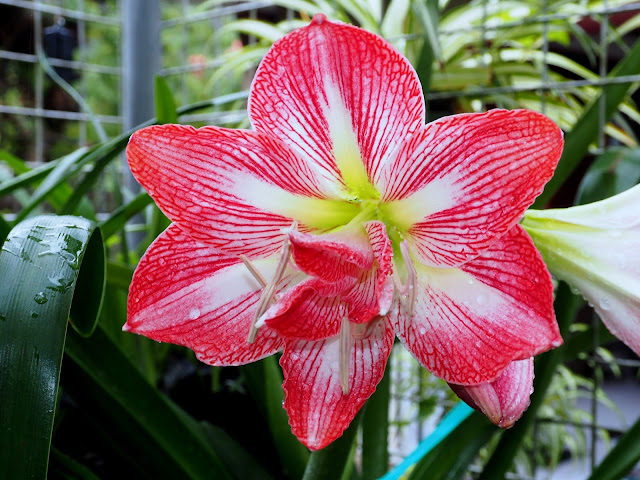Climate change is already a reality for all of us. Our Dry Season in March - May gave us an overheated environment, resulting in excessive electric bills for the airconditioning units and tripled water bills for those with gardens. There are also incidents of people suffering from strokes from jobs that entail too much heat exposures. I myself cannot just go home to the province every weekend because of heat on the roads. My plants suffered from neglect during those times. They are just watered insufficiently as our water supply also dwindled during hot months.
And there are unusual inconsistensies in terms of drizzles and short rains. We just had them starting in 2016, last year and this year. Sometimes it lessened the immediate heat, but eventually increasing the Heat Index because of the high humidity plus high temperatures. As for the plants, many are blessed by the sudden outpours. However, I as a gardener is not very happy with the effects of intermittent drizzles to my dormant bulbs. These include hippeastrum, crinum, blood lilies and a few more. The effects are much more obvious for the hippeastrum. My H puniceum hedges had intermittent blooms that did not give me a fully blooming spectacle like in the early 2000s. This brought me some sadness.
On the other hand, there is also a redeeming advantage, as i will show you below. Previous post in May shows the first
hippeastrum blooms.
Hippeastrum 1
I self pollinated one of my hippeastrum hybrids with the hope that i will be getting characters differently from the parent. This is a very old hybrid as my search landed on H x johnsonii, supposedly the first hybrid since 18th century. It was said to be a cross from H reginae and H vitatum, however we can never tell the truth for my bulb as hybridizing is easy and anybody could have done so in the long life of the hybrid that landed on me. I expect that characters segregate through constant selfing or backcrossing, eventually getting the characteristics of the parents of old. However, this entails a long time as it takes 3-4 years from seed to blooming.
My first original plant had 3-4 flowers per scape. My first offspring, ABA-1-1, bloomed last year and produced the same characteristics as my original plant. This 2nd sibling, ABA-1-2, bloomed now and has same characters. It also has undulating tepals.
Hippeastrum 2
The 3rd bulb, ABA-1-3, bloomed now for the first time and exhibited different characters. It has fully separated tepals and the shapes are thinner except the uppermost. The middle rays emanating from the throat is retained. The characteristic folding back of the tepals is a characteristics of the original plant.
The abaxial characters differed much from the original plant, with those dark maroon color at the base of the tepals.
Hippeastrum 3
This is another NOID plant given 2 years ago by a friend. Attempts to pollinate it failed because pollen grains seem to be defective, or not present. I wonder what caused those characters. It bloomed normally last year, but this time the pedicels did not separate fully producing a twin bloom.
The twin bloom is unusual for hippeastrum flowers, but they are beautiful that way.
One of the 3 flowers is separated showing the normal features.
Hippeastrum 4
The last gave me more excitement as i had been culturing this for 4 years from seed. A Facebook friend from the US gave me some seeds but did not know its parents, except that one is Blossom Peacock. She is just a collector and does not give particular attention to their IDs. The seeds gave me only 6 bulbs, with only this one producing the first flower. I am supposed to call it Blossom Peacock, but the blooms are much much different from it.
Blossom Peacock is a scented, multi-petalled hippeastrum. This offspring only has an addded single row of petals inside the main layer. The anthers look good although am not sure if there are viable pollens. She originally told me it was selfed, however the offspring told me otherwise. Now i went back to her and probed, eventually telling me the pod parent could probably be a very old Florida NOID hybrid. She even sent me the photo of the possible pod-parent. Doubles are normally the pollen donors because they normally lack productive stigma.
Even at the closed bud stage it is already lovely. This is the first bulb to flower, so i still have to closely watch the remaining 5 plants. I am sure some of them will flower next year.
The difficulty with hippeastrum is the single flowering once-a-year. It really is taxing to the impatient gardener like me. But i have no choice, i must be patient, withold the excitement for a few more years.
The first heavy rains in June was so good in bringing out the life from my dormant plants. And the almost simultaneous blooming of my precious ones gave me lots of joy. At least my first timers showed beautiful characters, eliciting more excitement in selfing, backcrossing, observing. There is only one drawback, the continuous rains washed out all the possible pollens. Being an incurable optimist, this gives me more excitement for the next years ahead.















